The post Feeling Tiny In Colombia’s Tayrona National Park appeared first on The Expeditioner Travel Site.
]]>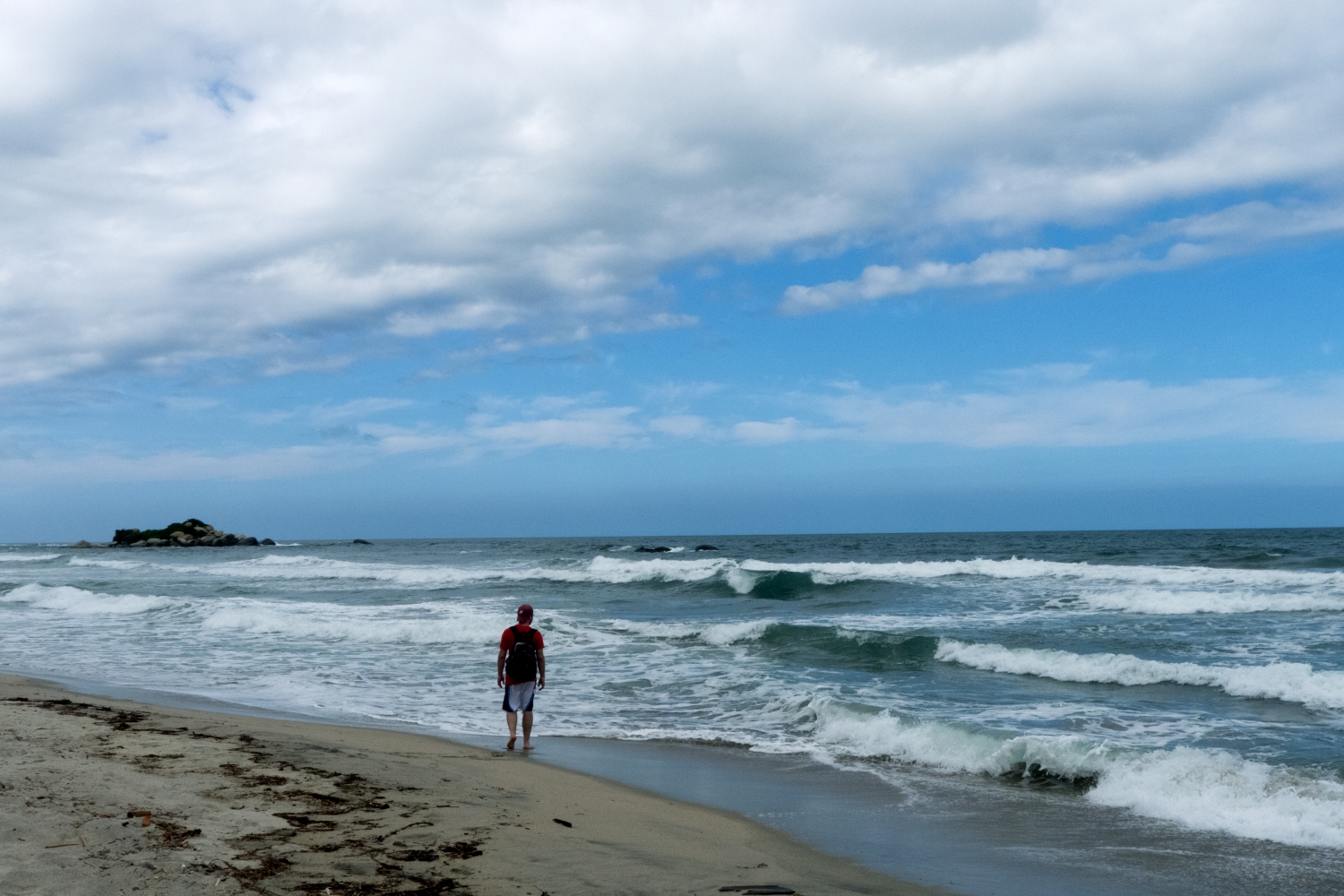
We stood at the entrance to a lush, tropical forest and confronted a simple yet profound choice. Do we proceed on foot, hauling our backpacks in the already thick morning air, or do we pay a local for the pleasure of mounting a time-worn horse?
We picked the budget option and started the hour-long walk into Parque Tayrona, a protected stretch of the Caribbean coast in Colombia. The park, which is really a beach cleaved from the outside world by dense forest, attracts a steady stream of foreign backpackers and appreciative locals. But even with nearly 300,000 people per year stopping by, it doesn’t feel crowded.
Or at least it didn’t in November 2011, when I visited there with an old friend and longtime traveling companion, Will. We had been friends since college where we bonded over spiced rum and grunge rock, and where later reached bro-for-life status when we both ended up in New York City after graduation. We had already road-tripped down the East Coast to New Orleans and across Southern France and Spain. Now we were in Colombia for a few weeks.
This may not be true for everyone, but I find I can divide travel into two types of experiences: city exploration and nature excursions (the guidebooks seem to back me up on this). We tried to mix things up, going from the intimidating urban sprawl of Bogota to a place called Valle del Cocora, where lanky Andean palm trees grow more than 100 feet in the air, making the humans underfoot look very insignificant. From there, we hit up some mountain-top thermal baths before partying in Medellin and Cartagena.
The time had come to refresh the soul (and the liver). Hence, to Tayrona.
The great part about Colombia is that two weeks actually do give you enough time to hop and skip your way across the country, even if you take the buses as we did. From Medellin, we downed some almost-too-easy-to-procure sleeping pills and took a mind-bending 24-hour bus ride to Cartagena. I fell into a dope-induced stupor but can recall images of Will vomiting into a small plastic bag (pills + switchback turns = regrettable mistake) and I believe I spoke sharply at the young boy sitting behind us, who was picking my pocket in a dream world.
We arrived just in time for Carnival festivities.
The scene was festive and chaotic: the locals packed the streets of an old, weathered neighborhood outside the city proper, sipping from small bottles of aguardiente, Colombia’s national paint remover, and squirting the gringos (us) with aerosol cans of foam and bags of water. Every now and then, someone would throw a deafening firework in our direction.
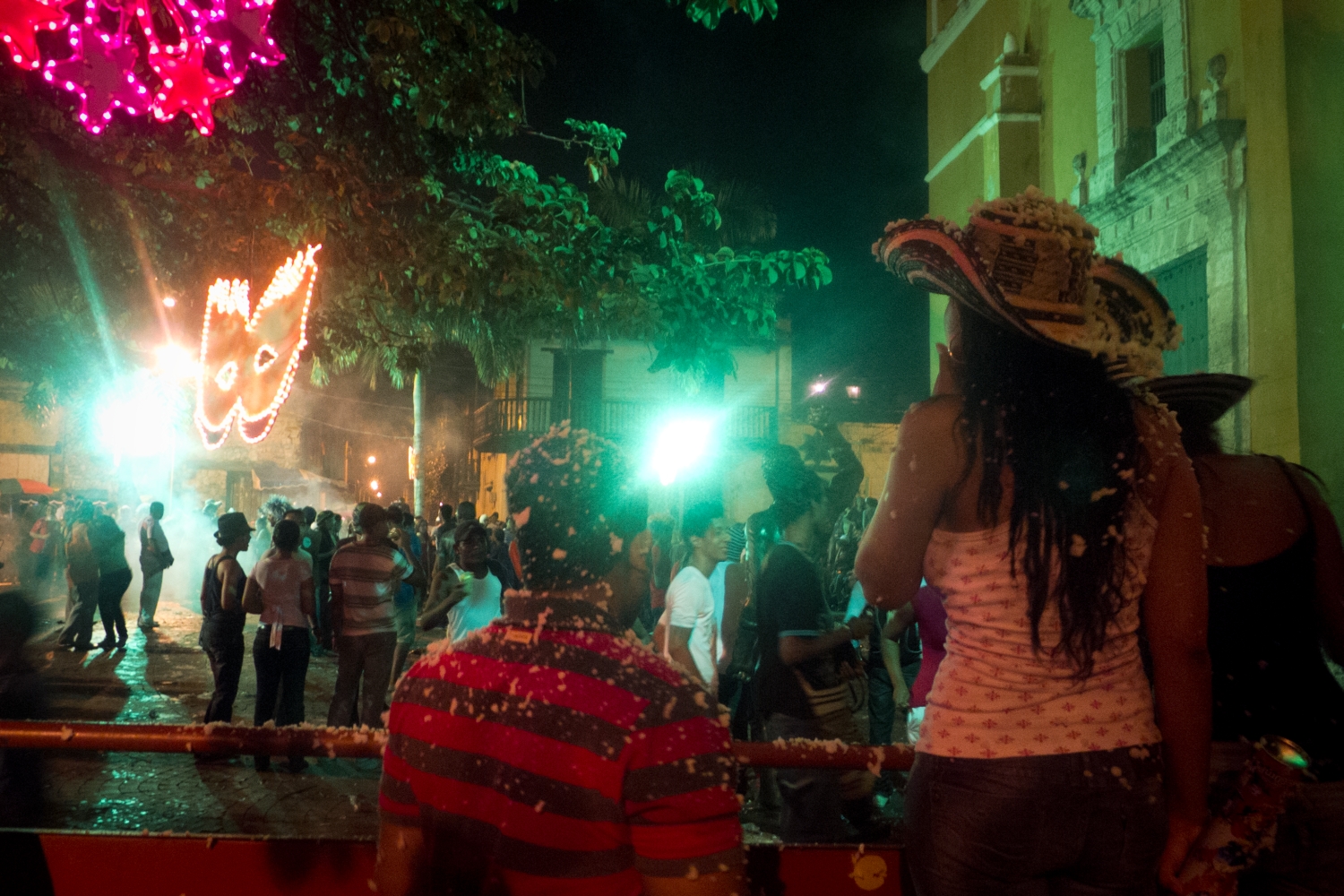
Somewhere on the spectrum of foam facial to flashbang, Will’s tolerance broke and he turned back for the hotel. I stayed out and danced in the streets with some German guys and a group of Colombian 20-somethings until one of the Germans got in fight with a hot dog vendor and it seemed wise to slink away to the hotel (after buying a hot dog myself, from a separate vendor).
We both felt pretty tapped out the next morning when we hopped onto another bus, this one to Santa Marta, a colonial city further up the coast that serves as a jumping-off point for Tayrona. We had probably hit the point of the trip where we were a little tired of each other, so a beach with no agenda seemed like a good idea.
The only issue was that it was Will’s birthday. I wasn’t about to sing to him on a moonlit beach or anything. But we were in our 30’s. I assumed it didn’t matter much to him.
The hike into the park was more challenging than expected. This was November and it had been raining a good deal, so the path was sometimes more mud than solid ground. The mounted travelers seemed to mock us even in their absence, since the path had been beaten down with the regular mash of hooves and repaved with horse shit.
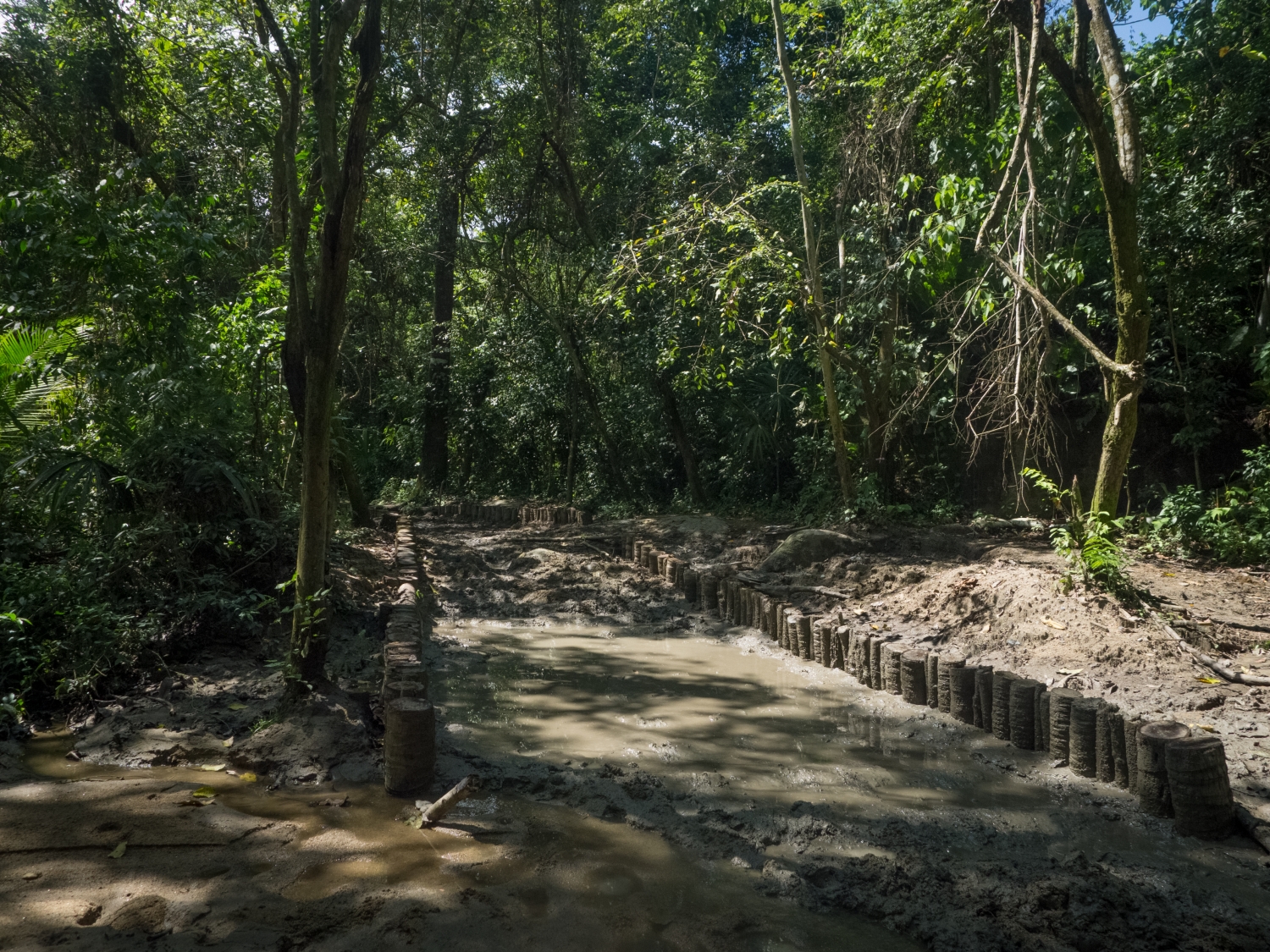
We stopped for a few breathers (the humidity!) and took in the surroundings. On the ground, a river of tiny green leaves moved up the path, carried by industrious leafcutter ants. We followed it with our eyes and the train of ants extended a long, long way.
My daily commute at the time wasn’t much different. I was working in the New York suburbs, wrestling with Long Island traffic on a daily basis, struggling to make rent, and feeling a lot like one of these tiny laborers. Presumably the ants weren’t gathering the preparations for a keg party.
Will, on the other hand, worked as a software engineer and spent the winter months away from New York, typically somewhere south of Texas. I can’t recall seeing an insect that would serve as a stand-in for his lifestyle, but maybe there’s some sort of dragonfly out there that fits the bill.
A little while later we reached the beach, ready to put down our things and take a dip. We passed several cabins, thinking it would be best to stay closer to the water, and eventually stopped at a beach campsite. A guy named Carlos came and greeted us. He showed us around the site, which consisted of an open-air pavilion with a television and tables for dining, as well as a sleeping area — a thick tree trunk with 8 or 10 hammocks ringing it like a pinwheel.
He said to throw our stuff in whichever hammock we wanted to sleep in. The cost was around $5 for the night. Easy enough.
We changed into our bathing suits and listened to Carlos riff on American politics (not a fan of George W. Bush . . . go figure) before we left for the water.
I’ve never felt that words are the best way to describe a landscape, especially if photos are available. But I would say this: the beauty of Tayrona felt both serene and brutal. The roar of the surf hit you first, but the surroundings stole the scene. The beach was ringed by a palm-studded forest that might remind an ignorant American (like me) of a movie about the Vietnam War. I imagined fleeing in a chopper while my compatriots zoomed by in fighter jets, setting off fiery explosions around me.
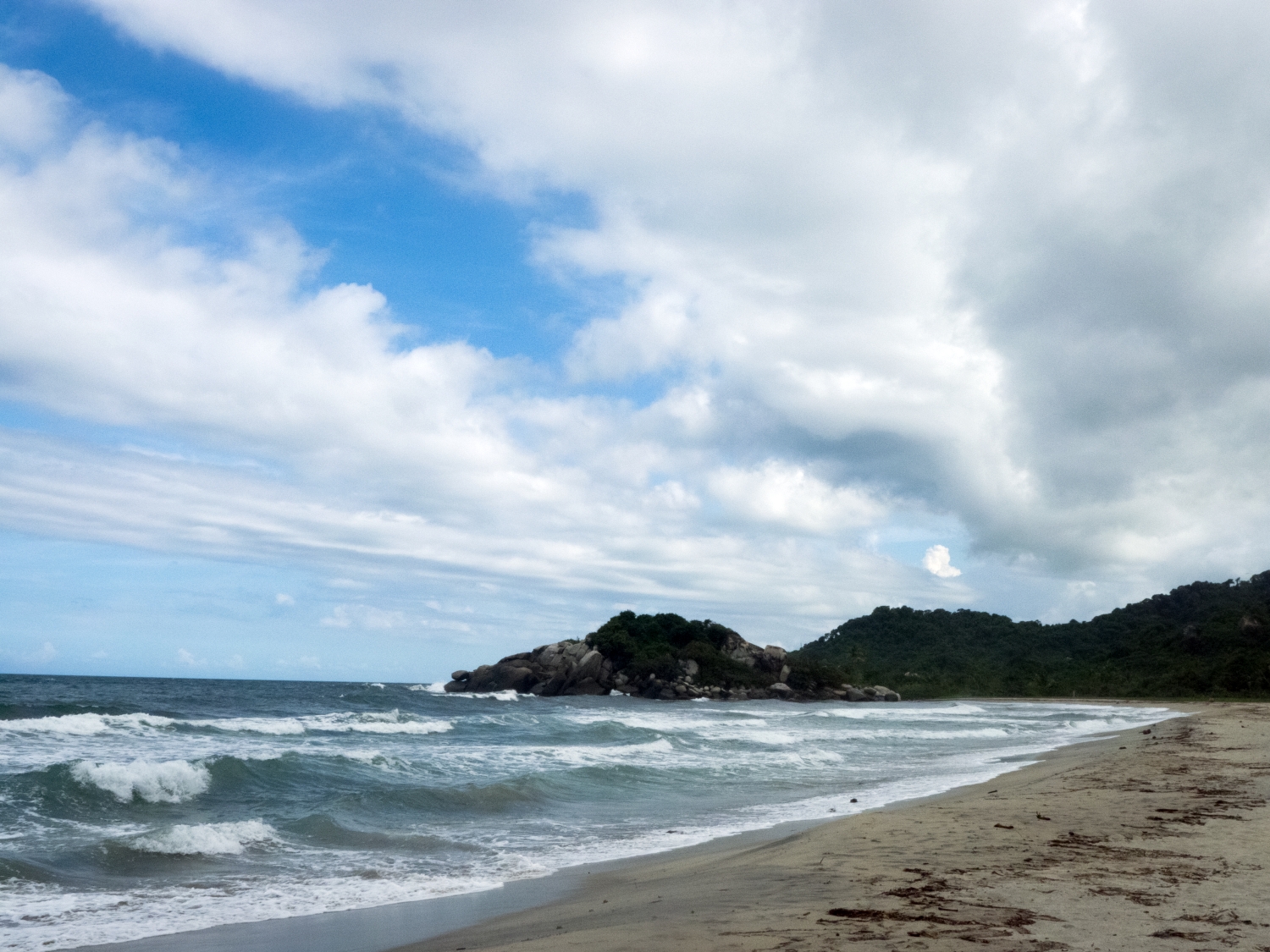
Gray boulders the size of a family sedan sat at the edge of the water — they weren’t going anywhere for a long, long time. We waded into the water up to our knees, but not much more. Carlos had told us not to swim near the campsite and one mention of the word “drown” was all I needed to hear.
We wandered down the beach, not saying much. What was there to say? This place was overwhelming. Everything was so alien to our daily lives, which were largely spent at keyboards (or in my case, in traffic). Through the trip, Will had been the photographer, but for a moment, we swapped roles and I snapped photos of him as he climbed onto one of these massive boulders. Something about those rocks made me think about the universe and whether it viewed me as anything more than a flimsy leaf struggling to hang on for another day.
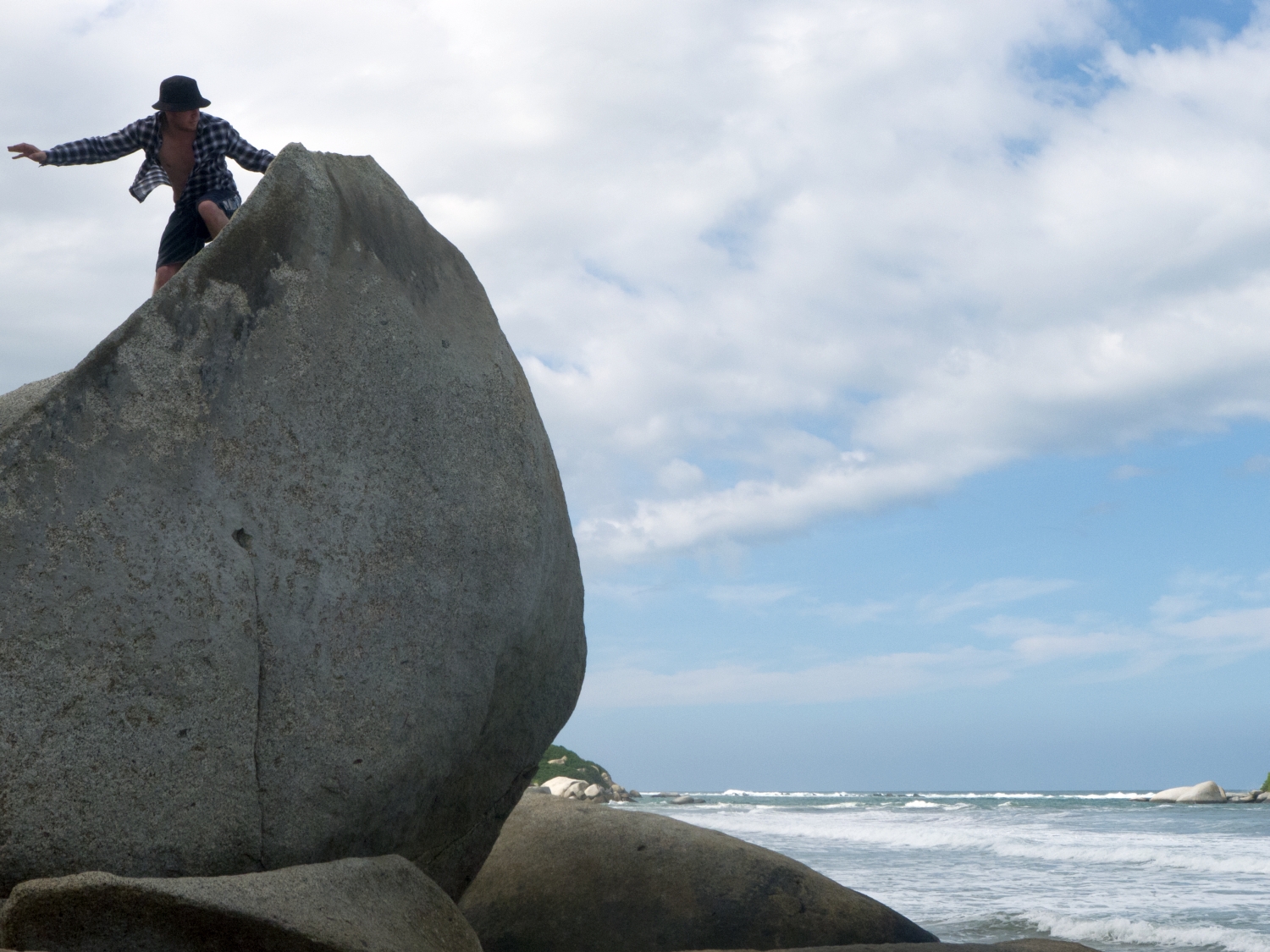
There was supposed to be a swimming beach somewhere down the coastline, but even after a decent walk, we couldn’t find it. The beach seemed to end; we ran into a wall of rock and palm trees. After wandering in muddy forest for 30 minutes or so, we backtracked and got directions from some German tourists.
The swimming beach was pristine and, at this point, a near-necessity, what with the sweating and exasperated tromping through coastal muck and such. The water shimmered the cool blue of a mellow mouthwash. We waded in.
And here’s another thing: it was nearly deserted. A pair of slim women stood down-beach, out of earshot. We didn’t swim out too far (again, the drowning thing) but it didn’t matter. This beach wasn’t for working out, it was for enjoying.
A long while passed there in the water. We eventually chatted with the women, who were both models, one retired, one still in the business. The retired one now owned a bar in Santa Marta and invited us to stop by when we got back to town.
We walked further into the park and reached a sort of mega-campsite where it appeared most of the backpackers flocked to see the sun rise in the morning. We didn’t stay here too long. The sun was still shining brightly, but it was past its peak.
When we returned to our camp, it was nearly dinnertime. We rested a bit in the hammocks and then sat down to eat. Carlos wasn’t around, but another guy running the kitchen brought me an enormous fried fish that made me very happy. While we ate, the other 7 or 8 guys watched a comedy show on the television.
After dinner, there wasn’t much to do. We wandered around a bit, looking for the type of unexpected off-the-hook party you might find in a beer commercial. No dice.
Instead, we made our way back to the campsite. The other guys staying there seemed to be laborers — I saw a couple of them cutting down a tree during the day — and they were watching a hard-core porno. We settled down into our hammocks to the sound of an enthusiastic gangbang.
Sometime later, everyone went to sleep. Will couldn’t nod off and asked if I wanted to head to the beach. Normally, I might have taken him up on the offer, but we were under mosquito nets on our hammocks and I deceived myself into thinking I might actually fall asleep. I told him to go ahead.
In the morning, I woke up to the sound of some chickens who clearly didn’t understand their place on the food chain. My ankles were itchy and when I rolled out of the hammock, I saw a solar system of red bumps around my knee.
I took a piss on the outskirts of the camp, near a blank-faced donkey. Everyone else was awake and gone except Will, who slept a bit longer. When he woke up, he was talking about the night before.
“It’s weird. It was like the best and worst way to celebrate a birthday,” he said.
“Oh yeah, happy birthday,” I replied.
He muttered something dismissive and went on with the story.
“There was lightning across the beach, no one out there. It was the most amazing shit I’ve ever seen in my life,” he said. “But then on the flip side, when I got back to this shitty-ass hammock, 5 dudes are fucking snoring like a symphony.”
I mentioned the red dots.
“Oh shit, you have those too?”
Will took a picture on the beach that night. There we were: standing on the edge of a continent. A storm rolled past. Waves maintained their endless roar. After the storm, there was a dazzling display of stars.
In this setting, we barely existed.
We hiked out of Tayrona and returned to Santa Marta, where we met the bar owner and her friend for drinks. We nursed whiskeys in an open-air courtyard and chatted with our new-found acquaintances and the handful of patrons.
I wondered about Will’s birthday: did he care that we spent it on a remote beach instead of downing shots in Medellin? Was I a bad friend for not taking these details into consideration? Tayrona was almost anti-birthday in a way, the sort of place where you seem very insignificant in the grand scheme of things. I decided not to worry about it.
The red dots on our legs kept itching for a few days. As it turned out, they were flea bites.

Photos by Will Benedict
/
 Ted Hesson is a multimedia journalist based in Washington, D.C. For more of his work, visit TedHesson.com.
Ted Hesson is a multimedia journalist based in Washington, D.C. For more of his work, visit TedHesson.com.
The post Feeling Tiny In Colombia’s Tayrona National Park appeared first on The Expeditioner Travel Site.
]]>The post Pleasure And Necessity: Expats Adrift In Antigua, Guatemala appeared first on The Expeditioner Travel Site.
]]>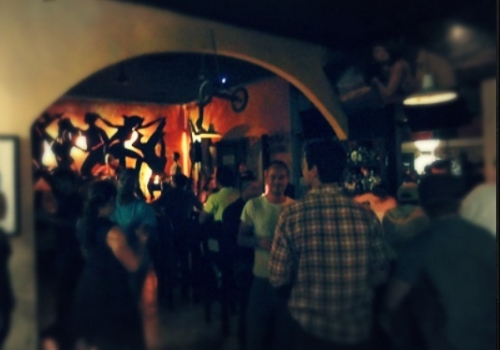
“Hop on! Just make sure you don’t burn your leg on the exhaust.”
I straddled the back third of the scooter seat behind my newfound gringo and gringa companions, Luke and Leta, and started looking for a bar or something to grab onto.
“Put your hands around my waist, no need to be shy,” Leta told me. Hearing that from an adorably freckled 20-year-old girl with bright blue eyes let me know that my night was beginning fortuitously, even if she meant it in a prosaic, crowded-scooter kind of way.
“We have to make a beer run first, hope you don’t mind,” Luke said. Or at least that’s what Leta relayed to me — I couldn’t make out most of the syllables from the front of the bike.
The jaunt to the convenience store was a short one but I was already enjoying the cool night air and the stares from the Guatemalan and European tourists heading to the bars and restaurants near Parque Central. We passed a Guatemalan police officer.
“You’re actually not even allowed to have two people on one of these,” Luke told us. “It’s to prevent drive-bys.”
Huh. I wasn’t surprised. I had just spent the week working in Guatemala City, one of the most dangerous cities in the Western Hemisphere. I actually enjoyed my time in Guate (GWA-tay), as locals call it, but the tension was undeniable. Guatemalans were constantly warning me to be careful, and I saw plenty of evidence that the warnings were justified. Nearly every storefront had an armed security guard, most of whom looked like nervous high school students. Every day, newspaper articles piled multiple murder stories into one big article, kind of like the morning fútbol round-up, except with more scoring. Several people mentioned to me that in 2009, more Guatemalan civilians were shot, stabbed or beaten to death than in the Iraq war zone. Ninety-seven percent of all murders in Guatemala go unsolved.
I was able to report my story without a single gunshot wound and didn’t have any other problems with crime, but the stories of kidnappings and roadside robberies had made me feel a bit paranoid, and I was looking forward to decompressing in Antigua before the flight back to New York. I had asked Matt Stabile, the editor of this website, whether he was interested in a story from Guatemala, and he recommended I get in touch with Luke Maguire Armstrong, a russet-headed friend of his who also contributes to The Expeditioner. A few e-mails and text messages later, I was riding caboose on Luke’s scooter, bouncing over cobblestones. As for Leta, she was a couchsurfer from Upstate New York passing through Antigua on a six-month trek through the Americas.
Luke put on his rounded helmet, looking like a dreamt-up spaceman from a bygone era, and we wobbled and swayed our way out of the busy, central part of Antigua. After maneuvering through a few quieter streets, we eventually reached an empty dirt road flanked by dense tropical brush; the headlight illuminated flashes of atavistic hunter greens and impudent harlequins. The beers were in cans and didn’t clang around too much on the rough terrain.
We reached a gated community and Luke spoke to an armed security guard in accented but competent Spanish. The guard wrote in a book quite deliberately for a few awkward minutes and then let us in.
“How do you two know each other?” Maggie asked Luke and me after inviting us inside. She was another gringa abroad, a friend of Luke’s, and was hosting us at the one-story house that she rented along with two Salvadoran twin brothers, one of whom she was dating. It had a stone fountain in the middle of the living room, a fireplace, big bedrooms and lots of reassuring bars on the windows, not to mention a couple of goofy-looking boxer puppies tromping around. I had to ask the inevitable question that New Yorkers ask everyone else in the world.
“We pay about $500 a month between the three of us,” Maggie told me. Did I mention that she had the muscle tone and firm personality of a capoeira instructor? At that point, I was finishing my first tall boy and feeling dreamily observant.
As I’ve done many times before, in places like Milwaukee and New Jersey, I proceeded to rant about just how ridiculously cheap her rent was, and how the apartment looked like the type of place that one could settle into and write a novel.
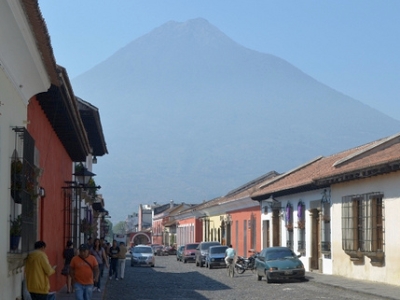 “It’s not that cheap when you’re working down here, earning Guatemalan money,” she said. “I’m bartending, so I basically make enough to cover rent.” I was already disconnected from any empathy I might have felt toward her situation.
“It’s not that cheap when you’re working down here, earning Guatemalan money,” she said. “I’m bartending, so I basically make enough to cover rent.” I was already disconnected from any empathy I might have felt toward her situation.
“I mean, if you could sell one or two freelance stories a month, you could live pretty nicely down here,” I said to no one in particular. “Jesus, my apartment looks like a fucking prison cell next to this place. You’ve got a fucking fountain in your living room.”
I never really got over the rent differential, but with a second beer, I at least turned my attention to other things. Luke had located two out-of-tune classical guitars and he handed me one.
“I don’t know how good those will sound,” one of the brothers said. I wish I could remember their names, but the truth is that I can’t even remember Maggie’s name; I made it up.
Luke tuned his guitar first. We didn’t have a tuner, so he used his ear. I imagined him harnessing an airy melody from the mountains surrounding Antigua. Once he was tuned up, I followed suit, siphoning a low E note, and then tuning the other strings against that. I wondered if the rest of the party – los gemelos, the fit girl, Leta – were dreading the unknown sound that the two of us would generate with these crippled instruments. But I didn’t care. All I wanted to do was play.
Luke began with a gentle, finger-picked ballad, over which I played accompaniment. I was grateful that he had a repertoire of songs to drawn on. We played a few more like that – Luke strumming the rhythm and singing, me adding fill. I overheard Maggie gathering everyone to leave for a bar as Luke started strumming what I figured would be the last song.
It sounded like an Irish pub song, and Luke sang some powerful vocals, the kind that are normally primed by years of drinking whiskey and not by a can and a half of Central American beer, but his voice sounded firm. We played it to its fullest for three verses and choruses, and then responsibly wound it down to a conclusion. Finished, we exchanged a look of mutual satisfaction. It was as if we had entered an acoustic brotherhood.
*
Outside, conversation shifted to the security situation in Guatemala, a thematic discursion likely prompted by the bars on the windows and the dude at the front gate wielding heavy artillery.
“Our friends were robbed,” Maggie said. “Even apartments with bars and security guards still get break-ins.” Someone gave me a cigarette and my buzz increased exponentially.
After another motorbike ride, the night continued at a rooftop bar: drinks, people, more conversations. The mountain air felt like aloe vera on my skin after the raw heat of Guatemala City. Once the party disbanded, Luke, Leta and I ended up back near where we started, sharing a bench in a now-sedate Parque Central.
“So you met Saul Kripke?” Luke asked me.
Actually, I had met Kripke. His name is pronounced “Crip Key.” I was working on a story for Time Out New York magazine about philosopher hangouts in NYC and I somehow ended up on the horn with a well-known art critic and philosopher whose name escapes me. He told me that Saul Kripke was one of the most famous philosophers in New York City. I gave Crip Key a call.
We met at Le Pain Quotidian a week or so later. I had never been there and, honestly, it seemed pretty lame. Kind of like a slightly cleaner Au Bon Pain and I’m sure I’m not the first to make that comparison. I was running late and I had to take a cab, which cut into my already insignificant paycheck. I decided I would only order a tea and wait for him to pick up the check.
Kripke was there, white haired, white bearded, and scrunchy-faced like a baby smelling pepper for the first time. He had a handler next to him, a beautiful young woman in her early 30s, possibly French or Israeli. Judging by how she manhandled philosophical jargon, she must have been an upper level graduate student, although she also appeared to have the kind of intimate knowledge of her employer’s life that you might expect from a personal assistant. Or maybe she was his wife or his daughter, what the hell do I know? They were sitting at an unvarnished table, a signature part of Pain Quotidian décor.
I was late for the meeting because I have a tendency to be late for things, but also because I had been doing some research on Kripke. I thought I had at least a common man’s understanding of philosophy, but Kripke’s stuff made no fucking sense at all. And I was only reading the Wikipedia entry.
Here’s one of his best quotes, according to Google Books:
Humphrey might have won the election (if only he had done such-and-such), we are not talking about something that might have happened to Humphrey, but to someone else, a “counterpart.”
On the topic of philosopher hangouts, Kripke didn’t have much to say. Actually, he seemed to object to the very premise of the interview, repeatedly telling me in a high-pitched and nasal but melodic voice, “I don’t really do anything all that interesting.”
He technically didn’t even live in the city. I think he had a place on the Upper West Side but he lived in Princeton and commuted a couple times a week. He seemed worried about the kind of piece I might write. I reassured him that the article would be of little interest to anyone. After about 30 minutes of haphazard chit-chat, he gave me the name of a supermarket in Princeton as one of his hangouts. I told him that it needed to be in the city.
“Oh, but I hardly ever go anywhere in the city. Sometimes we come here.”
I conceded that I’d have to eat the cab fare on this one, and then said goodbye to Kripke and his lovely Israeli/French sidekick.
*
Luke, Leta and I on the bench.
“Yeah, I met Kripke. Kind of a strange dude, but I guess even if his work is unintelligible it’s because of his level of genius.” And then I told them the story of Kripke.
I woke up the next morning with a legitimate hangover, but feeling the high that comes after a night full of pleasant surprises. I looked at the clock on my Guatemalan cell phone. Just after 10 a.m. Luke was supposed to be hiking a volcano. What a vigorous young man — my goal was brunch.
I showered, grabbed a newspaper and a bottle of water, and returned to the park, where I was supposed to meet Leta.
I haven’t said much about her. She was a bit of a hippie in disguise — a Marxist in J. Crew. The night before, she sat between Luke and me on the park bench with one knee hugged to her chest, saying how amazing it was to meet the two of us on the same day. After some degree of inner reflection, I decided I would participate in a threesome if that was what she was implying, but I knew it wasn’t.
“Sorry to keep you waiting, Luke just dropped me off,” she said. She looked limpid in a breezy dress and flip-flops. We grabbed some breakfast at an upscale Guatemalan café trafficked by tourists and weekenders from Guatemala City. I learned about Leta.
You meet a certain type of gringo backpacker in Latin America. Unlike in Europe, you don’t seem to run into study abroad students. Depending on the country, you won’t even encounter too many other American travelers (expect Kiwis by the jolly dozen). But the expat backpackers you do meet tend to speak Spanish, intoxicate freely and consider socialism a valid – if not necessary – form of government. They may or may not have dreadlocks, but in all cases, they respect people who do. In other words, these are cool folks.
Leta was no exception. After brunch we returned to Parque Central and passed more time on a bench. The plaza was still bustling.
“Tengo Biblias! Se vende Biblias!” A little boy — maybe eight years old — yelled, trying to sell Bibles in the square. Oddly, we had been talking about God, or the lack thereof, a little while before. The boy sat down on the bench next to Leta.
“Tengo Biblias,” he said halfheartedly. His gaze was fixed absentmindedly across the square. Apparently he didn’t sell a lot of these, or at least he wasn’t concerned with sales tactics.
“No creo en Dios,” Leta told him. The bluntness of her comment caught him like a slap in the face. He looked dazed.
“¿Y usted. Cree en Dios?” he asked me. “Sí,” I told him, even though the answer is probably more like, “I wish.” In a country where you could never have too much Jesus paraphernalia, I didn’t want to be the asshole who killed Santa Claus on a bright Saturday morning.
Leta was meeting with a friend later, and she pulled out an iPhone that she used for picking up WiFi. I can’t remember if she was actually checking the phone or just playing with it, but at least it shifted our conversation away from the absence of a benevolent deity.
The boy, his name was David, didn’t seem to be too familiar with the iPhone, and she showed him how the touch screen worked. He asked how much it was worth, and when she told him, in quetzales, I thought about how many Bibles he would need to sell to make that much money.
“¿Tu peso?” David asked. In addition to the Bibles, he had a scale that he carried around so that people could get an up-to-the-minute heft assessment. I told Leta she should try it, but in the end we both passed. David stayed with us a while longer on the bench, then decided to continue working the square.
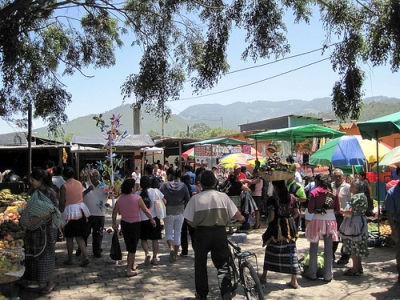 Leta and I took a walk to a nearby craft market that catered to tourists who were looking for something a little nicer than what you might find on the street. We walked into an open-air courtyard surrounded by stalls, and strolled from stall to stall, considering an occasional trinket: earrings, necklaces. I was looking for something for my girlfriend.
Leta and I took a walk to a nearby craft market that catered to tourists who were looking for something a little nicer than what you might find on the street. We walked into an open-air courtyard surrounded by stalls, and strolled from stall to stall, considering an occasional trinket: earrings, necklaces. I was looking for something for my girlfriend.
“I believe in polyamory,” she said. “I don’t think you should have to be with one person just because that’s what society tells you to do.” She went on to explain polyamory to me. I actually didn’t know exactly what it was. And, yes, I wanted to hear her talk more about it, and even see it in action, if possible. “I had this amazing sociology professor and I was talking to him about dating guys, and how I felt about it, and he said, ‘Maybe you’re polyamorous.’ And I think I am. It really does make more sense.”
Of course it does. At least to every guy in the world, including your professor, I thought. But let’s stay away from sexist stereotypes and listen to Leta talk about polyamory.
“This isn’t about sex. I only have sex with one guy. It’s about relationships. There are things that some guys can give me that others can’t, and vice versa. I may want to spend time with a guy, and really enjoy his company, but not fuck him. That’s how polyamory works.”
I was a little surprised/disappointed that her philosophy wasn’t pegged around casual and exhaustive sex, but she certainly had a good point.
We finished perusing the crafts and she offered to take me over to another market, one where locals shopped. It wasn’t far away. We approached some fruit vendors with big baskets of mangos, papayas, guavas and avocados, as well as loads of other fruits I didn’t recognize. We walked between the vendors into an indoor market, a conglomeration of simple wooden stalls covered overhead by corrugated metal panels. We passed people selling all types of foodstuffs: spices out of open sacks, fish, Guatemalan pastries. The walking lanes were narrow and crowded.
There may have been other gringo tourists, but if so, I didn’t see them, and the market didn’t seem particularly geared toward out-of-towners. Mostly people were selling essentials. The vendors were grouped in sections. After the food, we passed through an area where people were selling wooden chairs, followed by an area with electronics, and an area with clothes.
I was running low on clean laundry and bought a pair of socks with the word “UMBRO” stitched into the fabric; the price was negligible by US standards. I got the impression that Guatemalans from more rural areas around Antigua traveled into town on Saturdays, or maybe every day, to sell their wares at this market. Labyrinthine would have described it, and after five minutes of shuffling from stall to stall amid the crowds, I felt the intoxication of the minotaur’s prison, at once amazing and overwhelming.
In an area that could have been the center of the maze, we found some eateries serving traditional Guatemalan dishes. The mini-restaurants were lined up one after the other, people cooking more or less in the open, and a few picnic tables and benches where you could sit down and eat. We found an open table and ordered the menu of the day, soup and fried chicken. I ordered a Coke.
“My problem is that I’ve been dating the same girl for years, but I still don’t want to get married,” I told Leta. “I feel awful. I know she wanted that years ago, but I’m just not ready. I tell myself that I might be ready eventually, but when I think about it, I just can’t believe that will be the case.”
“Then why are you still doing it?”
“It’s complicated,” I said. “We should probably break up, but it’s not that easy.”
A young lady brought my Coke and a glass of ice.
“Should I drink this with the ice?” I asked Leta, afraid of the consequences of drinking unfiltered water. “I’d rather not drink it warm, and they already put ice in the glass.”
“Just drink it, you’ll be fine,” she told me.
By Ted Hesson
[Guatemala by Marina Villatoro/Flickr; Remaining photos by Matt Stabile]

About the Author
 Ted Hesson is a multimedia editor and producer based in Manhattan. For more of his work, visit TedHesson.com
Ted Hesson is a multimedia editor and producer based in Manhattan. For more of his work, visit TedHesson.com
The post Pleasure And Necessity: Expats Adrift In Antigua, Guatemala appeared first on The Expeditioner Travel Site.
]]>The post Amid Drug Violence, Can You Still Travel To Rosarito Beach? appeared first on The Expeditioner Travel Site.
]]>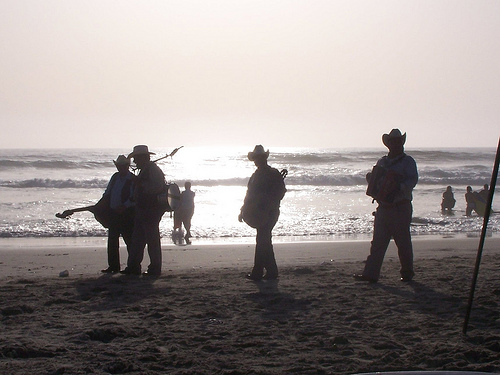
By Ted Hesson
From the car in the outlet mall parking lot in southern San Diego we could see a winding stretch of the border fence; beyond the fence, tawny hills and tough shrubs, terrain that was wilder and more natural than Southern California’s artificially landscaped residential neighborhoods. A giant tri-color flag — green, white, and red — flapped in the breeze. Mexico.
My friend Will and I sat in the bed of his Toyota pickup truck on a Wednesday morning in late July, searching on our phones for information about crossing the border without a passport, since Will had forgotten his documentation at his apartment in San Francisco.
Passport issues aside, we also had some concerns about safety. Will and I were in the midst of a weeklong trip to Southern California in late July, and before reaching San Diego, we had spent some time in Los Angeles and the San Diego suburb of San Marcos. At each stop, I sounded out my friends about a possible day trip down to Rosarito Beach, the 130,000-person Mexican city 30 miles south of the U.S. border. Each friend gave me the same response: Don’t go.
I wasn’t surprised. Back in New York I report on immigration issues, and I had read article after article about the brutality of the drug war in Mexican border cities and towns, and how the violence has escalated in recent years. When I Googled “Rosarito” and “crime,” I found articles about beheadings, executions, and kidnappings.
A decade ago, California residents — gringo and Latino alike — would day-trip down to Rosarito and Tijuana in search of good fish tacos and cheap booze, as well as illicit pleasures, like drugs and prostitution. But over the past few years, increasing news reports about violent crime, occasionally against Americans, caused tourism to plummet. The H1N1 flu scare in 2009 didn’t help matters, either.
After reading so much about the border, though, I wanted to draw my own conclusions.
So, in spite of Will’s passport situation and warnings from friends who said that we “shouldn’t even go through the turnstile” into Mexico, we found ourselves sitting in front of a Ralph Lauren outlet store nearby the border, contemplating whether or not the trip would be possible.
Will’s white Toyota pickup truck is actually decorated with black vinyl stickers so that it resembles a spotted cow (just for decoration/general amusement), and it wasn’t long before a white-haired, white-mustached mall security guard approached us on a golf cart.
I told the guard about our plans to visit Rosarito, and, as it turns out, he actually lives there and commutes to work in San Diego. Hearing the security guard — a staid-looking, retiree-aged gringo — speak about Rosarito, the trip seemed perfectly feasible: Will didn’t need a passport, a California driver’s license would do; we could take Federal Highway 1D along the coast in Mexico for some nice scenery and to avoid the frenzy of Tijuana; and we could buy daily car insurance at a place near the outlet mall for as cheap as $5.
I asked him about the violence. “Yeah, there are killings, but that’s only between the cops and the cartels,” he said. “If you’re not part of that, they’ll leave you alone.”
With that, we thanked him, bought some insurance, and drove towards the border.
***
In March of this year, three U.S. Consulate employees were shot to death in Ciudad Juárez, the Mexican city to the south of El Paso, Texas. Among the victims was a married couple — the wife pregnant — who were shot in their car as their seven-month-old daughter sat in the backseat. In July, Mexican police arrested a gang member linked to the Juárez drug cartel.
After the high profile killings, the U.S. Department of State issued an advisory for US citizens traveling to northern Mexico, citing the escalating drug violence.
But in some ways, the advisory just documented what those living on both sides of the border already knew: Americans believe that Mexican border towns are too dangerous to visit.
Rosarito tourism statistics reflect a fall-off in cross-border tourism: In 2000, Rosarito hotels had a 45.8% occupancy rate, according to Mexico’s Secretary of Tourism. By 2008, that figure had declined to 26%, amid years of steady decline.1
In California, my friends had spoken about nightly news reports of violence along the Mexican side of the border. Such reports are not misleading: Since Mexican president Felipe Calderón took office in December of 2006 and launched his war against cartels, 28,000 people have died in drug-related violence, and some of the brutality, if not directed at tourists, has taken place in Rosarito. The day before our July visit, a Rosarito police commander was shot and killed after allegedly uncovering a human trafficking operation.
In spite of those realities, Rosarito’s mayor, Hugo Torres, has been campaigning to change the city’s image, touting a 21% drop in crime in 2009, and a murder rate that has been more than halved, from 54 killings in 2008 to 26 in 2009. And organizers of tourist events, like the Rosarito-Ensenada 50-Mile Bicycle Ride and last year’s Rosarito Beach Surf Pro AM Competition, have made an effort to stress the relative safety of tourists.
Our first impressions after crossing the border from San Diego into Mexico didn’t exactly inspire confidence in the government and infrastructure.
“This looks how I would imagine Iraq would look,” I told Will as we drove towards the coastal highway to Rosarito, with the border fence to our right. We passed dilapidated shantytowns, shells of buildings, and sun-worn men hiking what appeared to be long distances along the side of the highway. The overcast sky — remnants of what the Southern California set call “June Gloom” –– further darkened the mood.
“Wow, it’s a totally different world over here,” Will said. We had cruised through the border checkpoint without needing to show any documentation, and suddenly found ourselves amid crumbling buildings that would have stood out like a decaying tooth in San Diego.
As we reached the coastal highway, though, the blight eased, replaced by the blue and white surf to the west and cinder block houses and small ranches to the east, with low-lying hills in the backdrop. I was somewhat surprised by the prevalence of new real estate along the 30-minute oceanside trek. Condos and gated developments cropped up along the way, many of them in an unfinished state of construction. Signs advertised new homes and condos for anywhere between $60,000-$100,000. Seemed like a steal, compared to what people were paying in La Jolla and Pacific Beach.
“I wonder if the guy from the mall lives in a place like that?” I asked Will.
We followed signs for Rosarito and meandered our way through the city center, the architecture of which reminded me of Latin American cities that I had visited before, including Oaxaca in the south of Mexico. Along the road we saw two-story body shops, restaurants with hand-painted names, cell phones stores — none of the businesses appeared particularly active.
We started to notice some hotels along the main drag, and soon enough I caught a glimpse of aquamarine water down a narrow cross street. We decided to ditch the truck in a parking lot and head towards the sand.
As we walked down to the beach, we tried to get a sense for the city’s vibe. Part of me had expected there to be an element of the legendary Tijuana party scene, which one particularly revelous family friend had described to me as, “All you can drink for $15; you’re drinking, go outside, throw up, come back in, drink some more . . . Having fun.”
Along the walk to the water, we passed a few establishments that might have facilitated “having fun” at one point in time — two-tier bars that seemed perfect for booty shaking and club jams, but each of them was either empty or closed.
Down by the water, we noticed that the June Gloom had burned off, and it was sunny now with an even breeze blowing across the beach. We also got our first taste of Rosarito’s competitive informal economy. Young men vied for us to come drink at each of their respective bars along the beach, but we thanked them and continued on, opting for a cursory walk along the surf before settling down at a table and chairs.
For a Wednesday, there seemed to be a decent amount of people on the beach — although it definitely wasn’t crowded — but the patrons appeared to be Mexicans or U.S.-citizen Latinos on vacation; we hadn’t seen any other gringos since the outlet mall back in San Diego. Walking for about 20 minutes or so, we saw mostly families on the beach. It reminded me of my childhood vacations in Ocean City, New Jersey, a family resort town that was perfect for parents and kids, but not the sort of weekend binge spot that might have better served our demographic.
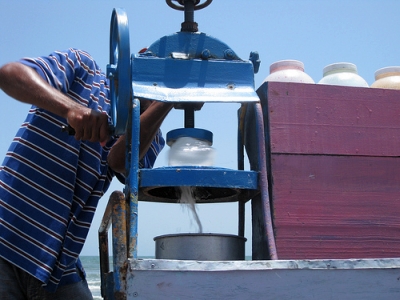 We passed vendors along the beach selling peeled mangos; bags of chicharrones, the orange-colored fried pork rinds; and raspados, the Mexican version of a snow cone. I eventually went to work on an elote, roasted corn on the cob dressed in salt, lime, chili sauce, and grated fresh cheese.
We passed vendors along the beach selling peeled mangos; bags of chicharrones, the orange-colored fried pork rinds; and raspados, the Mexican version of a snow cone. I eventually went to work on an elote, roasted corn on the cob dressed in salt, lime, chili sauce, and grated fresh cheese.
The corn was a start, but we were ready for a more substantial meal. The beachfront bars were all pretty quiet, with only a handful of customers, so we picked a spot based on one waiter’s promise of a $10 bucket of mini-Coronas.
Not surprisingly, the bar was out of mini-Coronas, but we settled for a couple of $3 Pacificos without complaint. As our waiter, Carlos, took our lunch order — fish and carne asada tacos — we also mined him for some information about tourism in Rosarito.
“Most of these bars seem pretty quiet,” I said. “Is that because of the time of year, or are things slower than they used to be?” After some hesitation, Carlos started talking about the decline in tourism.
“There are stories in the news about killings or headless bodies found in Rosarito, but that’s happening in Tijuana and they’re dumping the bodies here,” he said. “They’re never writing stories about the good things that are happening here.”
Like the security guard, Carlos thought that violent crime was only a problem for those tied to police or the cartels. Also, like the security guard, Carlos had lived on both sides of the border: he lived and worked in Reno for more than a decade until he was deported in 1995, leaving his wife and two children in the states. Both he and his wife had remarried.
Some parts of Rosarito that Carlos mentioned didn’t seem so safe. When I asked him if there were any clubs or bars that we should visit, he referenced a place nearby called Bada Bing, where, for a price, you could get a lap dance or have sex. “Anything you want,” he said.
We decided to pass on that option since a) shady strip clubs weren’t on our agenda; and b) heading to a place like that seemed like inviting trouble. A Google search for Bada Bing later turned up an article about the club owner’s 2007 kidnapping and a startling (if unverified) review of the club that mentioned cartels, HIV transmission, and women forced to work under debt bondage. Maybe it was a perfectly legitimate adult entertainment club, but we didn’t have any interest in investigating it.
We ordered another round of Pacificos and Carlos brought the tacos. I had the fish, which matched well with lime and beer. As we ate, a steady stream of vendors approached our table hawking bracelets, cigars, and small trinkets. Will bought a few small wooden turtles from a girl who couldn’t have been more than six or seven years old, and I eventually bartered for some cigars to give to a friend back in San Diego. Although a new vendor seemed to approach every few minutes, no one pushed us to buy anything.
We finished our tacos, but we had some leftovers: refried beans, rice, and chips. One young vendor, maybe 12 years old, stood silently nearby our table until our waiter realized that the boy was waiting for the leftovers. Carlos put the leftovers onto one of our plates, and allowed the boy to sit at the table next to us and finish the meal.
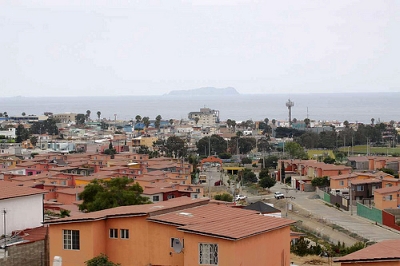 As we settled the check, Carlos told us that it “hurt” to see food go to waste, especially considering the cost of certain food items in Mexico. In the past decade, he said, the prices of certain groceries had risen compared to the prices for the same thing in the US, all this despite Mexico’s weaker currency and higher unemployment. His sentiments echoed what I had learned about food prices during a January research trip to Oaxaca.
As we settled the check, Carlos told us that it “hurt” to see food go to waste, especially considering the cost of certain food items in Mexico. In the past decade, he said, the prices of certain groceries had risen compared to the prices for the same thing in the US, all this despite Mexico’s weaker currency and higher unemployment. His sentiments echoed what I had learned about food prices during a January research trip to Oaxaca.
Still digesting our meal, we walked toward the entrance of a long pier, passing by a group of guys renting horses and all-terrain vehicles. We had watched the horse and ATV crew while we were eating, and they hadn’t had any customers, save one little girl who they guided around on horseback. Not much business.
The pier was busy with local fishermen and families, some watching fathers and brothers set hooks, and some strolling the length of the planks, taking in the expanse of ocean below.
Past the beach, the pier connected to the Rosarito Beach Hotel, arguably the most notable landmark in the city, and we decided to go inside. Originally a hunting lodge and converted to a hotel in 1925 (according to the brochure), the complex included a very green lawn beyond the beach, a swimming pool, ornately tiled hallways, and an antique bar and dining room that resembled 1950s Havana.
I grabbed a drink at the bar and we considered the possibility of staying the night. In the end, we opted to return to San Diego, taking into account a timetable that had us back in L.A. the next day. The hotel seemed like the perfect spot for a weekend getaway, though, and rooms can be found for as low as $100, according to the website.
With the sunlight fading, we hopped into the truck and rerouted up the coast toward the border. Had we stayed the night, we probably would have hung out at the hotel or at one of the other hotels along the beach, for safety reasons.
Our trip wasn’t over just yet, though, as Will made a wrong turn near the border that deposited us in downtown Tijuana. Amid the confusion, he actually drove the wrong way down a one-way street, which gave us the opportunity to meet one of TJ’s infamous police officers.
As the officer disembarked from his SUV and approached our truck, a few thoughts crossed my mind: Will didn’t have his passport and we had almost no money in the event that we needed to pay a mordida, (a bribe, or, literally, a “little bite”). I had no interest in sampling a Tijuana jail cell.
The officer asked Will for his driver’s license as we tried to explain, in a mix of English and Spanish, why he had driven the wrong way down the street. After looking at Will’s license for a moment, the officer pointed to one of the cow spots on the truck. “¿Es una vaca?” he asked.
The cow question broke this ice, and the officer then gave us directions to San Diego. No bribe, no jail cell; overall a pleasant, if nerve-wracking, experience.
In his rear-view mirror, Will watched the cop return to his car. “That guy was carrying some sort of assault rifle.” I hadn’t noticed.
Aside from worries about violence, my friends had also cited the long lines to return to the US as a deterrent for crossing the border, and the congestion on this particular evening was no different. While we inched our way towards the states, a parade of vendors passed by our truck: fresh orange juice, beach towels, a ceramic depiction of The Last Supper. I bought some churros, for $0.75.
Just as on the beach, most vendors strolled up and down the roadway advertising their wares, but not pushing us to purchase anything. With that in mind, I was somewhat surprised when one bracelet-selling boy, maybe six years old, stopped at my window after I said, “No, gracias.” He stayed there for a minute or so, and I felt uncomfortable — a child his age, weaving between cars, hawking cheap merchandise. After a minute or so, he walked away.
We were a bit nervous at the border. I was fairly certain that U.S. citizens were supposed to carry a passport to Mexico (they are), so I was curious how this might unfold (i.e., would they usher us into a windowless room while agents dismantled the cow truck looking for packs of cocaine). We explained our situation to the agent, how we had been told that a California license would suffice for U.S. entry. After some questions from the agent, including Will’s place of birth, we passed into San Diego.
We felt like the day trip was a success, even if it was only a limited taste of life on the other side of the border. We hadn’t experienced any problems with crime or violence, thankfully, but I knew that if I returned, I would definitely employ the same sense of caution.
One casualty of the trip was that the truck had gotten a bit dusty, which I noticed the next morning as we left San Diego for LA. In the dust of the passenger’s side door, however, was a message, apparently written by the six-year-old vendor who had paused at my door while we sat in traffic at the border. In playful scrawl, it read, “VACA VACA VACA.”
By Ted Hesson

[Rosarito Beach Mexico by Kiara Ramirez/Flickr; Raspado by Lauren Arcer/Flickr; Rosarito by Ted Hesson/Flickr]
Ted Hesson is the online editor of Long Island Wins, a website devoted to immigration news, policy, and culture in Nassau and Suffolk counties.
The post Amid Drug Violence, Can You Still Travel To Rosarito Beach? appeared first on The Expeditioner Travel Site.
]]>The post Road Trip: New Orleans Style appeared first on The Expeditioner Travel Site.
]]>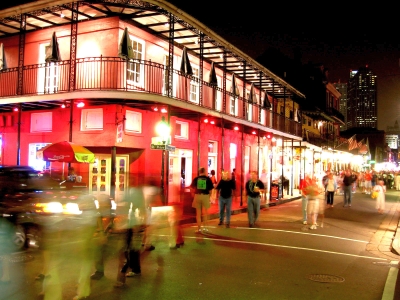
Still recovering from that bender known as Katrina, a road trip to the Big Easy reveals how New Orleans isn’t letting a little hangover prevent it from enjoying life, just like it always has.
By Ted Hesson
We decided to take a road trip for several reasons: moving, freelance work, sightseeing, hell-raising, escapism, rock and roll — the usual motives. Since it was freezing cold in New York, the three of us thought it would be smarter to move southerly before hanging a right towards the West Coast. While my two friends ventured on to California, though, my final stop on the trip would actually be New Orleans, a city that I had always wanted to visit. I expected to find, among other things: heaps of spicy seafood, Bayou-tinged blues, unparalleled architecture, non-stop debauchery and the remnants of one of the worst natural disasters in the history of the United States. For better or for worse, it was all there.
From Atlanta, we took the slow road to the Big Easy, making a few stops along the way. We spent an hour in Montgomery, where we discovered a Disney-esque downtown devoid of inhabitants, save some chatty pharmacy workers, with whom we talked about New York, Alabama’s quiet capital and, eventually, New Orleans. “Y’all goin’ to New Orleans?” one worker said. “Na, I wouldn’t go if I were you. Y’all gonna get boogled.” Our Yankee ears must have translated it poorly, because I’m sure what she meant to say was that we would get “voodooed,” but either way, I got the point. She thought New Orleans seemed pretty freaky, and as a childhood fan of Anne Rice, I didn’t disagree. But, to put things in perspective, it was rush hour in Montgomery, and I hadn’t heard a honking horn or shouting pedestrian yet. Seemed to be just as good of a chance of getting boogled here as anywhere else. We hopped back in the van and decided to take our chances with whatever witchcraft might lay in wait.
As we drove along Route 90, the strip malls and stoplights became a bit repetitive, but we never lost the ominous feeling inspired by the uprooted oak trees that flanked the road, part of the scars and scabs on the debris-speckled Gulf Coast. This stretch of highway was hammered by Hurricane Katrina but apparently had been restored in November 2007. If there was anything else worth seeing as we drove through the rest of Mississippi, I probably missed it. Relegated to the back of the van, I crashed out on a couple of beanbags until we hit Louisiana.
When I woke up, the landscape had changed dramatically. Sand, surf and palm trees had morphed into swampy bogs. The bayou. Wide-eyed, we rolled along 90, taking in the gray-green landscape, which was occasionally accentuated by an abandoned wreck or roadside fire. It wasn’t long before we came across a hunting party, with dozens of cars parked along the sides of the road. My first, more romantic impulse was to guess that they were shooting gators, or perhaps hunting a swamp rat of mythical proportions, but they were probably after ducks or quail. When we stopped to take some photographs a little farther down the road, we heard gunshots.
* * *
By the time we reached New Orleans around 5 p.m., we were ready to stretch our legs. Well, that or hunker down on the nearest barstool. Turns out those stools were at Fat Harry’s, a smoky pub with sticky tables and friendly faces, where we planned to meet our friend Sara whose house we’d be crashing at that week. Uptown — the neighborhood southwest of the French Quarter — where Sara lived was one of the places that didn’t flood during Katrina because of its higher elevation, and although some of the buildings in the historic area suffered wind damage, we didn’t see any visible reminders of the storm.
We met Sara at the bar and ordered a few bottles of something called Purple Haze. If the uprooted trees on our ride towards the city felt foreboding, a beer named after a Hendrix song seemed quite the opposite. As it turns out, the Haze, a light, raspberry-flavored wheat beer, is made by the local brewing company Abita, so we were getting a taste of the native drink as well. After we chatted with Sara for a bit (Her thoughts: “Wow, these guys look balder and fatter than I remember them”), she suggested we walk to Casamentos Oyster House for dinner. We wanted to finish our beers first, but soon realized that chugging would be unnecessary: we watched as the locals poured their drinks out of their pint glasses and into plastic cups.
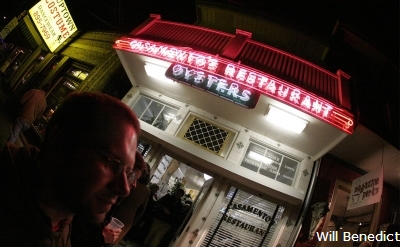 Beers in hand, we headed toward Casamentos (4330 Magazine St., 504-895-9761), about a five- or ten-minute walk down Napoleon Avenue to a part of Uptown that was closer to the Touro neighborhood. On the way, someone pointed out St. Elizabeth’s, a former orphanage that was purchased by Anne Rice in 1993 and transformed into the kind of vampire-esqe lair that you might expect to find in one of her books. The entrance to the enormous red brick building — heralded by Corinthian columns and guarded by stone seraphim — hinted at the incorporeal, despite the fact that the property had been sold a few years back and converted into condominiums.
Beers in hand, we headed toward Casamentos (4330 Magazine St., 504-895-9761), about a five- or ten-minute walk down Napoleon Avenue to a part of Uptown that was closer to the Touro neighborhood. On the way, someone pointed out St. Elizabeth’s, a former orphanage that was purchased by Anne Rice in 1993 and transformed into the kind of vampire-esqe lair that you might expect to find in one of her books. The entrance to the enormous red brick building — heralded by Corinthian columns and guarded by stone seraphim — hinted at the incorporeal, despite the fact that the property had been sold a few years back and converted into condominiums.
When we got to Casamentos — one of the best oyster houses in the city — we ran headfirst into a 45-minute wait. After some discussion — and fresh beers from the bar next door — we decided to head elsewhere. I was a bit disappointed. With its tiny tables and tiled walls, Casamentos seemed to have a lot of character. “The tiled walls make it easier to clean up after mob hits,” I overheard someone say as we were leaving.
Outside, a friend of Sara’s pulled up in an SUV, and we all crowded inside and headed to Frankie & Johnny’s (321 Arabella St., 504-899-9146), a traditional Nawlins Cajun joint in the southwest section of Uptown. From the neon beer signs in the front windows to the drop ceiling and checkered tablecloths inside, the restaurant felt homier than my grandmother’s living room (although I don’t ever remember her serving beer in pitchers). We sat down at a big table in the back of the restaurant and asked our friends to help us order. More than anything, we wanted to try food from the bayou, so for appetizers we settled on a mess of broiled crawfish, gator nuggets and fried pepper rings.
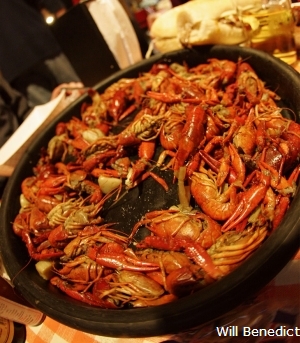 When the crawfish came out we felt a bit helpless. Here we had a heaping pile of blushing crustaceans in front of us and not the remotest idea of what to do next. Luckily, Sara demonstrated for us, pulling the head off on an inaugural critter, squeezing the meat out of its tail, and then slurping the spicy juices out of the detached head — all the while maintaining the posture of an airline stewardess. On my first try, the crawfish juice exploded on my shirt and glasses, but before long I got the hang of it and I was pulling, squeezing and sucking as if I was the star of a seafood-lover’s fetish film. The gator bites, which came with remoulade sauce on the side for dipping, were good, but pretty much tasted like chicken and perhaps weren’t as exotic as we had anticipated.
When the crawfish came out we felt a bit helpless. Here we had a heaping pile of blushing crustaceans in front of us and not the remotest idea of what to do next. Luckily, Sara demonstrated for us, pulling the head off on an inaugural critter, squeezing the meat out of its tail, and then slurping the spicy juices out of the detached head — all the while maintaining the posture of an airline stewardess. On my first try, the crawfish juice exploded on my shirt and glasses, but before long I got the hang of it and I was pulling, squeezing and sucking as if I was the star of a seafood-lover’s fetish film. The gator bites, which came with remoulade sauce on the side for dipping, were good, but pretty much tasted like chicken and perhaps weren’t as exotic as we had anticipated.
For dinner we ordered po’ boys of all different varieties: oyster, catfish, chicken, hamburger. Po’ boys are essentially subs with some sort of fried fish or meat in the middle, but make no mistake: these are po’ boys — not subs, not hoagies and not even “poor boys.” These are po’ boys. Respect. I ordered mine with fried oysters and asked for it “dressed,” meaning that I wanted the sandwich with lettuce, tomato, mayonnaise and pickles. During the course of the meal, I took a bite of just about everyone’s po’ boy, and I have to say, they were all pretty delicious. It’s hard to go wrong with fried fish on full-bodied, flaky, baguette-like bread.
After a nightcap at a local watering hole (it was only 10 p.m., but the beer had been flowing unsparingly all night), we retired to Sara’s place, which was what they call a shotgun house. Yep, you guess it: that essentially means that you should be able to stand at the front door, shoot a firearm through each room of the house, and have the bullet go out the back door without hitting anything. Imagine the real estate deal: “Can I shoot my gun through it? I’ll take it.” Aside from the structural points, the house felt time-tested, as if it could speak to a century’s worth of hurricane parties, crawfish boils and Mardi Gras parades. There were even impish little gargoyles decorating the front door, and I got the feeling that one could get boogled if he or she wasn’t careful.
* * *
The next day we woke up with a few cobwebs in the brain, but soon realized that a late-night rainstorm had given way to a bright and temperate Sunday morning. Sara and her husband had some social obligations to tend to, so the rest of us decided to relocate to a hotel on Bourbon Street and spend the afternoon and night carousing there. Though before parting ways, Sara took us out to breakfast at The Trolley Stop (1923 Saint Charles Ave, 504-523-0090), an affordable greasy spoon in the Lower Garden District where I treated my hangover with a plateful of biscuits and gravy, sausage, and intravenous fountain Coke. As we ate, we watched an occasional streetcar pass by the window. Sara explained that streetcars are never called trolleys in New Orleans, despite the restaurant’s moniker. Afterwards, we all felt a good deal more healthful (strange that sausage can have that effect), and we climbed back into Sara’s car for a quick drive around the city, including what she laconically called the “death and destruction tour” of neighborhoods that had been damaged by the storm.
We worked our way down St. Charles Avenue, fawning over the magnificent rows of houses on either side of the road, and occasionally flabbergasted by a library or school that looked more like an aristocrat’s mansion. From there we passed through the CBD, which sounds like a government agency or a venereal disease, but in actuality stands for “Central Business District.” The CBD is where you’ll find New Orleans’ high-rise office buildings and hotels, not to mention the Superdome. After that we continued on to the French Quarter, passing by dozens of eye-catching but quaint Creole cottages, painted pink, peach and turquoise.
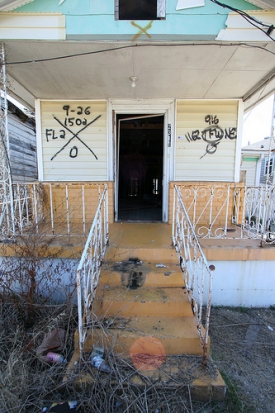 Eventually, we reached the Upper Ninth Ward. During the ride, we passed some storm-wrecked buildings and a few homes with black X’s spray-painted over their front doors, a relic from the days after Katrina when rescue teams marked the homes that had been evacuated. But it wasn’t until the Upper Ninth Ward that we got our first taste of the devastation that the storm had wrought. The neighborhood had been restored, but most blocks still had houses in disrepair, slumping and battered ghosts that would hang around until the owners could scrape together enough money to repair them. We passed a section of new houses called the Musicians’ Village, where Habitat for Humanity built over 70 homes in the Upper Ninth Ward for working musicians and their families. Although there weren’t many people around, the on-going construction let us know that the rebuilding process was making headway.
Eventually, we reached the Upper Ninth Ward. During the ride, we passed some storm-wrecked buildings and a few homes with black X’s spray-painted over their front doors, a relic from the days after Katrina when rescue teams marked the homes that had been evacuated. But it wasn’t until the Upper Ninth Ward that we got our first taste of the devastation that the storm had wrought. The neighborhood had been restored, but most blocks still had houses in disrepair, slumping and battered ghosts that would hang around until the owners could scrape together enough money to repair them. We passed a section of new houses called the Musicians’ Village, where Habitat for Humanity built over 70 homes in the Upper Ninth Ward for working musicians and their families. Although there weren’t many people around, the on-going construction let us know that the rebuilding process was making headway.
As we approached the bridge to the Lower Ninth Ward (the two areas are separated by the levied canal), I felt a bit stunned and shell-shocked. It was hard for me to imagine that so many people had lost their homes, and that even after more than three years time, this neighborhood (along with many others) still bore the imprint of the disaster.
Compared to the Upper Ninth Ward — which was battered but in the midst of restoration — the Lower Ninth Ward felt more like a vast vacant lot. We saw the homes that had been built by Brad Pitt’s Make It Right Foundation, which set out to construct homes in the area that would be weather resistant, ecologically conscious and architecturally bold. The homes stuck us as pretty ugly, but the fortress-like designs gave the impression that the buildings could withstand the Gulf Coast’s yearly onslaught of storms, if not another Katrina. Raised on concrete legs, each house had its own strange geometric shape, reminiscent of a Martian settlement dreamed up in the 70’s, while the colors — asparagus, sun-bleached banana and cerulean blue — evoked the shades of the small cottages that were washed away by Katrina. They might be an eyesore, but there was something fresh about the houses, and they hinted at a hopefulness that was harder to see as we passed by the empty concrete foundations and piles of scattered debris that made up the majority of the neighborhood.
After the tour, we said our goodbyes to Sara and found a hotel room on Bourbon Street. While my friends went off to take photographs around the French Quarter, I holed up in Bourbon Rocks, a serviceable, open-air sports bar where I planned to watch a playoff football game. Some might think that was a waste of a beautiful afternoon, but I couldn’t imagine a better way to experience Bourbon Street then at a dingy bar with three-for-one drink specials (three bottles of light beer for $4.50). Needless to say, I was feeling boisterous by the time I met up with my companions at the end of the game, and I was glad that they had brought me a beignet — a deep-fried local pastry that comes blanketed in powdered sugar — to offset the last round of Miller Lite.
We wandered up and down Bourbon Street for the rest of the night, marveling at the hordes of spots to hear live funk, blues and rock bands, as well as the prevalence of dance clubs. Well, not dance clubs exactly, but clubs where the dancers are paid to dance. Around 10 p.m., we refueled at the Oceana Grill (739 Rue Conti, 504-525-6002), a kitchy, somewhat pricey dive just off Bourbon Street, where we made short work of a fiery plate of jambalaya and a bowl of shrimp gumbo. Afterwards, we wandered back down Bourbon Street, entranced by the rambunctious energy of the music, booze and overall good times.
And that was New Orleans: spectacularly spooky architecture, addictive food, the ever-present memory of a calamitous hurricane — all those things that defined the city. Yet on Bourbon Street, a carotid artery of soppy locals, wide-eyed tourists and pushers of every sort, you felt the pulse of New Orleans, a city that will always be ready to embrace the next day, headache or no headache.
The three of us, on the other hand, had been through all we could handle, and Yankee that I was, I boarded my flight back to New York the next day with a feeling of fulfillment and relief. A few hours later I landed safely at JFK Airport, a little tired, but to the best of my knowledge, free of any voodoo curses.
By Ted Hesson

About the Author
Ted Hesson is the online editor of Long Island Wins, a website devoted to immigration news, policy, and culture in Nassau and Suffolk counties.
The post Road Trip: New Orleans Style appeared first on The Expeditioner Travel Site.
]]>